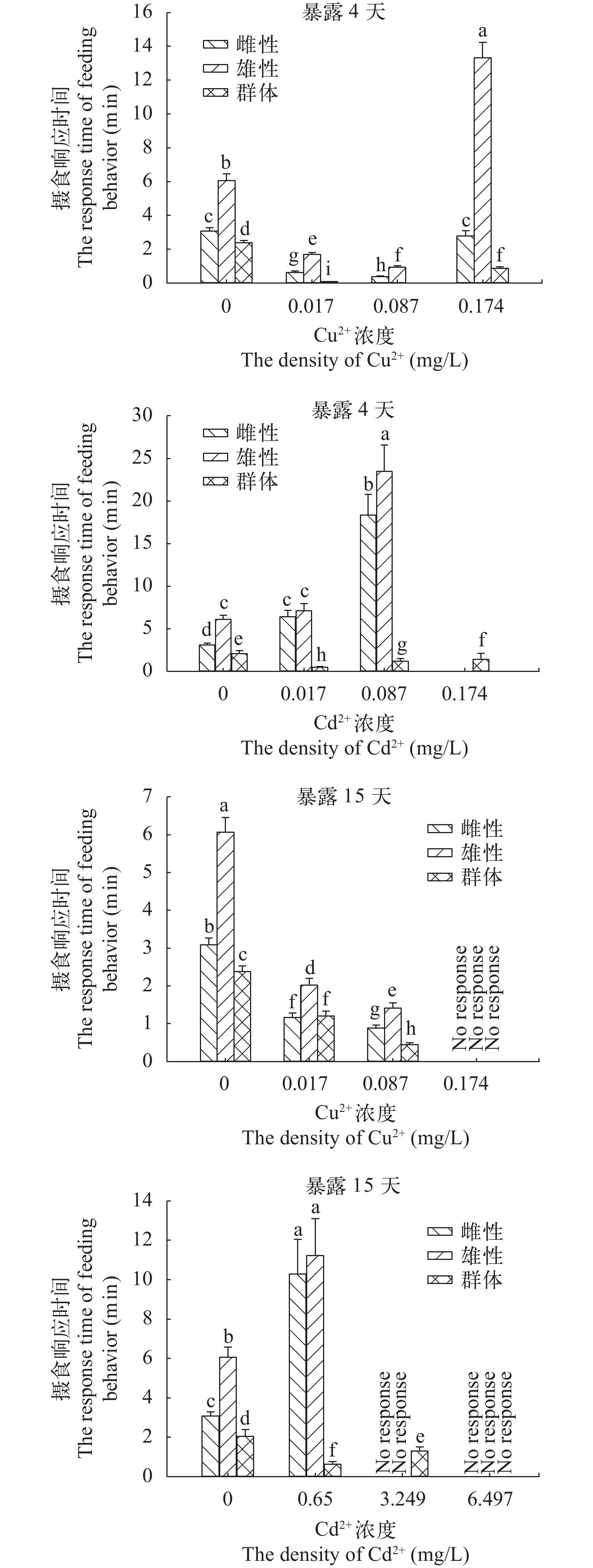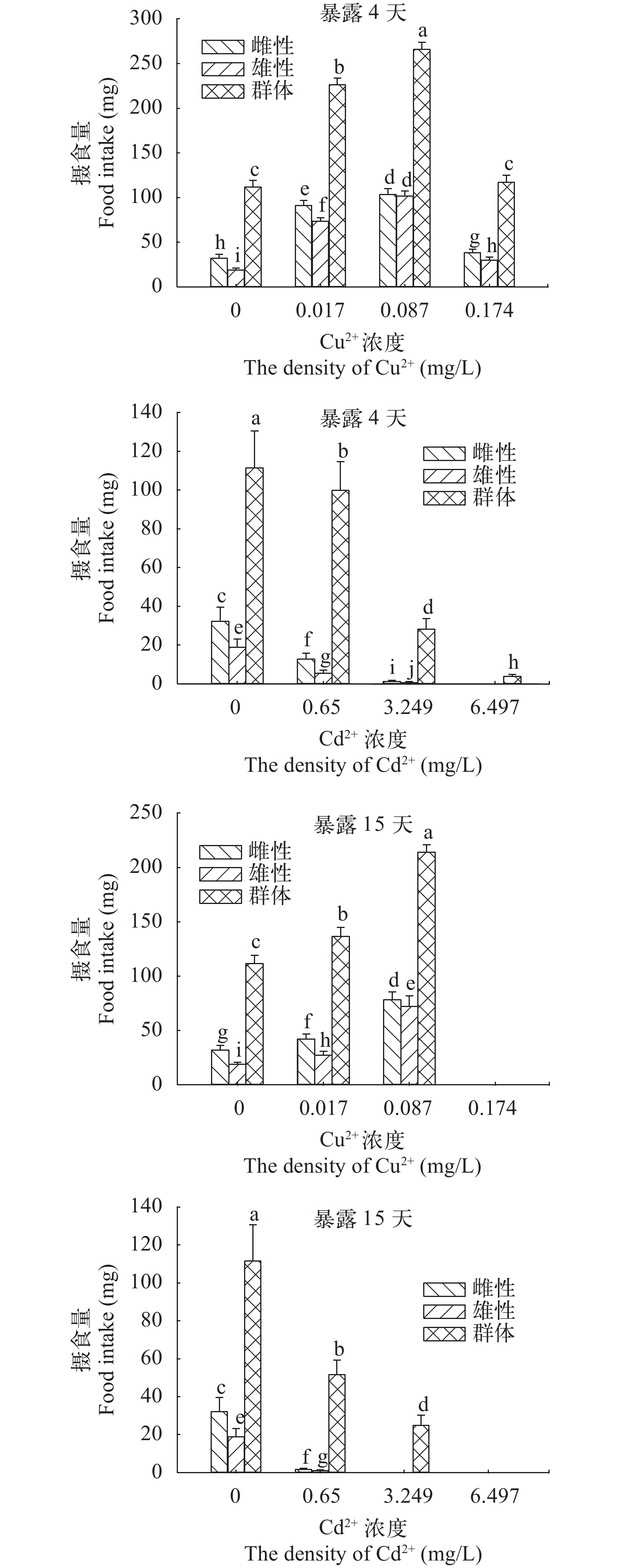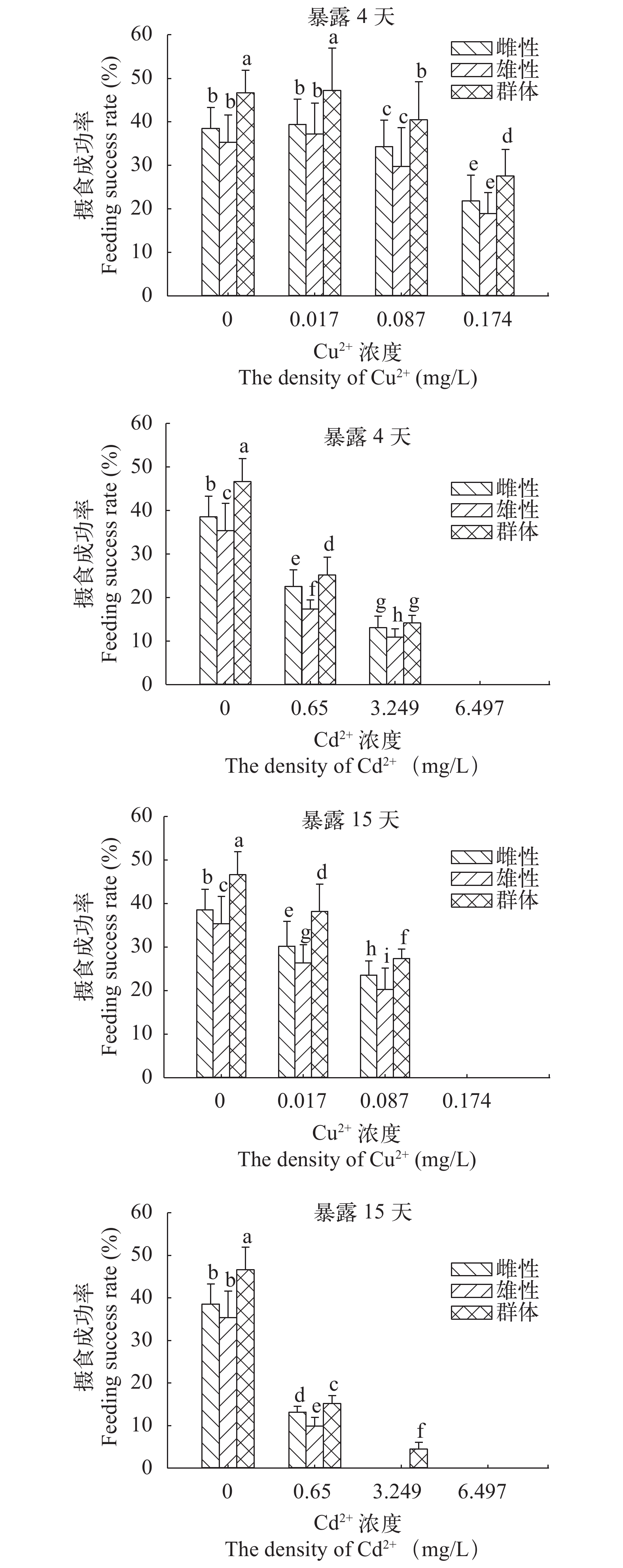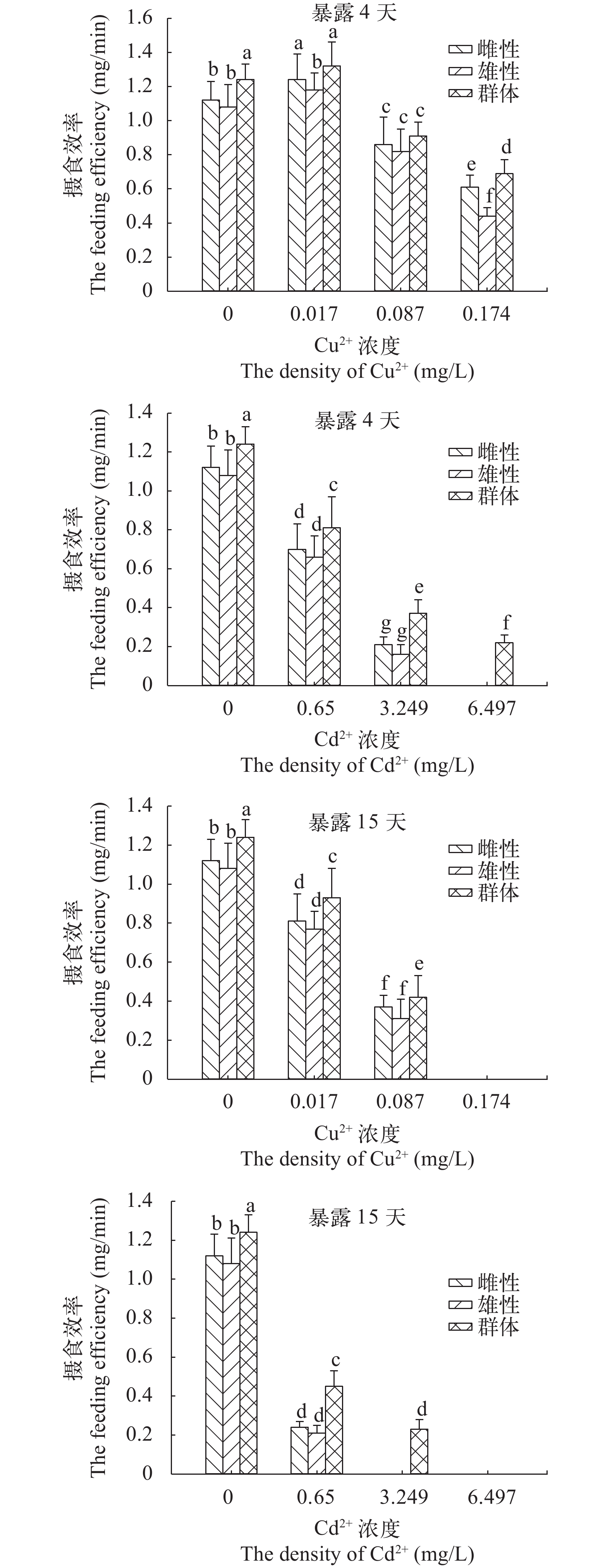EFFECTS OF Cu2+ AND Cd2+ ON THE FEEDING BEHAVIOR OF ORYZIAS MELASTIGMA
-
摘要: 以海洋青鳉(Oryzias melastigma)为试验动物, 分析了铜和镉两种重金属离子胁迫对海洋青鳉摄食行为特征的影响, 包括摄食响应时间、摄食量、摄食成功率和摄食效率等参数。结果显示, 随着Cu2+浓度的升高, 开始时, 海洋青鳉的摄食量有所升高, 当Cu2+浓度达到0.087 mg/L时有最大的摄食量和最短的摄食响应时间。随后, 摄食量出现下降, 在0.174 mg/L时达到最低。低浓度的Cu2+还能提高海洋青鳉的摄食成功率和摄食效率, 而Cu2+的高浓度和长时间暴露则降低海洋青鳉的摄食成功率和摄食效率。Cd2+对海洋青鳉的摄食行为具有明显的抑制效应, Cd2+抑制海洋青鳉摄食的最低可见效应浓度为 0.65 mg/L, 摄食量、摄食成功率和摄食效率均随着Cd2+浓度的升高而降低。此外, 在Cu2+和Cd2+胁迫下, 对食物的响应时间有性别差异, 雌性显著短于雄性, 还存在群体显著短于个体等现象。Abstract: In this study, we used Oryzias melastigma as the experimental animal and used Cuprum and cadmium as the test drugs. The effects on the feeding behavior of Oryzias melastigma exposed to Cu2+ and Cd2+ were analyzed, including the response time of feeding behavior, food intake, the success rate of feeding and feeding efficiency. The results showed that with an increase in the Cuprum concentration, the food intake initially increased to the maximum food intake, associated with the shortest feeding response time, and then decreased at a concentration of 0.174 mg/L. A low concentration of Cu2+ improved the feeding success rate and feeding efficiency of Oryzias melastigma, while a high concentration of Cu2+ and long-term exposure resulted in the opposite effects. Cd2+ had a significant inhibitory effect on the feeding behavior of Oryzias melastigma, and the lowest observed effect concentration of Cd2+ that inhibited the feeding of Oryzias melastigma was 0.65 mg/L. Moreover, the food intake, feeding success rate and feeding efficiency decreased with an increasing Cd2+ concentration. The response time to food was significantly shorter for females than for males, and that of the group was significantly shorter than those of individuals.
-
Keywords:
- Oryzias melastigma /
- Heavy metals /
- Cu2+ /
- Cd2+ /
- Feeding behavior
-
-
-
[1] 陈生涛, 苗安洋, 温婷婷, 等. 辽东湾表层沉积物重金属污染特征及潜在生态危害评价 [J]. 海洋环境科学, 2019, 38(2): 256-262. doi: 10.12111/j.cnki.mes20190214 Chen S T, Miao A Y, Wen T T, et al. Heavy metals in the surface of Liaodong bay and their potential ecological risk [J]. Marine Environmental Science, 2019, 38(2): 256-262. doi: 10.12111/j.cnki.mes20190214
[2] 周文敏, 傅德黔, 孙宗光. 中国水中优先控制污染物黑名单的确定 [J]. 环境科学研究, 1991, 4(6): 9-12. doi: 10.3321/j.issn:1001-6929.1991.06.003 Zhou W M, Fu D Q, Sun Z G. Determination of black list of China’s priority pollutants in water [J]. Research of Environmental Sciences, 1991, 4(6): 9-12. doi: 10.3321/j.issn:1001-6929.1991.06.003
[3] Felten V, Charmantier G, Mons R, et al. Physiological and behavioural responses of Gammarus pulex (Crustacea: Amphipoda) exposed to cadmium [J]. Aquatic Toxicology, 2008, 86(3): 396-425.
[4] Martnez M, Del Ramo J, Torreblanca A, et al. Effect of cadmium exposure on zinc levels in the brine shrimp Artemia parthenogenetica [J]. Aquaculture, 1999, 172(3-4): 315-325. doi: 10.1016/S0044-8486(98)00431-1
[5] 张换敬, 乔波, 汪安泰, 等. 铜、镉、铅离子对水螅摄食行为的抑制作用 [J]. 水资源保护, 2008, 24(3): 17-19. doi: 10.3969/j.issn.1004-6933.2008.03.005 Zhang H J, Qiao B, Wang A T, et al. Inhibitory effect of Cu2+, Cd2+ and Pb2+ on the feeding behavior of hydra [J]. Water Resources Protection, 2008, 24(3): 17-19. doi: 10.3969/j.issn.1004-6933.2008.03.005
[6] 王茜, 郭鹄飞, 王兰. 镉对大型溞摄食能力和相关生理指标的影响 [J]. 水生生物学报, 2018, 42(3): 616-621. doi: 10.7541/2018.077 Wang Q, Guo H F, Wang L. Effect of cadmium on the feeding capacity and physiological status of Daphnia magna [J]. Acta Hydrobiologica Sinica, 2018, 42(3): 616-621. doi: 10.7541/2018.077
[7] Williams C R, Gallagher E P. Effects of cadmium on olfactory mediated behaviors and molecular biomarkers in coho salmon (Oncorhynchus kisutch) [J]. Aquatic Toxicology, 2013, (140-141): 295-302.
[8] Kevin H, Keith T, Gallagher E P. Comparative effects of cadmium, zinc, arsenic and chromium on olfactory-mediated neurobehavior and gene expression in larval zebrafish (Danio rerio) [J]. Aquatic Toxicology, 2018, (201): 83-90.
[9] Sloman K A, Scott G R, Diao Z, et al. Cadmium affects the social behavior of rainbow trout, Oncorhynchus mykiss [J]. Aquatic Toxicology (Amsterdam)
, 2003, 65(2): 170-185. [10] Kuz’Mina V V. influence of zinc and copper on the latency period for feeding and the food uptake in common carp, Cyprinus carpio L [J]. Aquatic Toxicology, 2011, 102(1): 73-78.
[11] 黄灿克, 刘婷婷, 汤晓畏. 发光细菌毒性法在饮用水水质评估与预警中的应用 [J]. 环境监控与预警, 2015, 7(3): 4-7, 21. doi: 10.3969/j.issn.1674-6732.2015.03.002 Huang C K, Liu T T, Tang X W. Application of the photobacteria toxicity detection method in water quality assessment and early warning of drinking water [J]. Environmental Monitoring and Forewarning, 2015, 7(3): 4-7, 21. doi: 10.3969/j.issn.1674-6732.2015.03.002
[12] Shioda T, Wakabayashi M. Effect of certain chemicals on the reproduction of medaka (Oryzias latipes) [J]. Chemosphere, 2000, 40(3): 239-243. doi: 10.1016/S0045-6535(99)00235-0
[13] 梁鸿, 刘勇, 饶凯锋, 等. 水环境中重金属铜暴露下青鳉鱼的行为响应 [J]. 生态毒理学报, 2016, 11(6): 345-352. Liang H, Liu Y, Rao K F, et al. The behavioral responses of the Medaka under the stress of heavy metal copper in water environment [J]. Asian Journal of Ecotoxicology, 2016, 11(6): 345-352.
[14] Kong R Y C, Giesy J P, Wu R S S, et al. Development of a marine fish model for studying in vivo molecular responses in ecotoxicology [J]. Aquatic Toxicology, 2008, 86(2): 131-141. doi: 10.1016/j.aquatox.2007.10.011
[15] Bo J, Cai L, Xu J H, et al. The marine medaka Oryzias melastigma-a potential marine fish model for innate immune study [J]. Marine Pollution Bulletin, 2011, 63(5-12): 267-276. doi: 10.1016/j.marpolbul.2011.05.014
[16] Dong S, Kang M, Wu X, et al. Development of a promising fish model (Oryzias melastigma) for assessing multiple responses to stresses in the marine environment [J]. Biomed Research International, 2014, (1): 563131.
[17] Freret-Meurer N V, Andreata J V, Alves M A S. Activity rate of the seahorse Hippocampus reidi, Ginsburg, 1933(Syngnathidae) [J]. Acta Ethologica, 2012, 15(2): 221-227. doi: 10.1007/s10211-012-0125-1
[18] Vincent A C J, Evans K L, Marsden A D. Home range behaviour of the monogamous Australian seahorse, Hippocampus whitei [J]. Environmental Biology of Fishes, 2005, (72): 1-12.
[19] 王晓杰, 肖潇, 李超, 等. 海洋酸化对海水青鳉胚胎骨骼发育的影响 [J]. 海洋学报, 2015, 37(12): 116-122. Wang X J, Xiao X, Li C, et al. Impact of ocean acidification on skeletal development in embryonic marine medaka [J]. Acta Oceanological Sinica, 2015, 37(12): 116-122.
[20] 王晓杰, 连丞, 降瑞婵, 等. 海洋酸化对青鳉鱼(Oryzias melastigma)耳石形态和成分的影响 [J]. 海洋环境科学, 2018, 37(2): 168-174. Wang X J, Lian C, Jiang R C, et al. Effect of ocean acidification on the otolith shape and composition in marine medaka (Oryzias melastigma) [J]. Marine Environmental Science, 2018, 37(2): 168-174.
[21] Changkeun L, Bong-Oh K, Seongjin H, et al. Sub-lethal and lethal toxicities of elevated CO2, on embryonic, juvenile, and adult stages of marine medaka, Oryzias melastigma [J]. Environmental Pollution, 2018, (241): 586-595.
[22] 倪晓敏. 六价铬长期暴露对海洋青鳉鱼的毒性研究 [D]. 厦门: 厦门大学, 2018: 105-131 Ni X M. The toxicity of long-term hexavalent chromium exposure on marine medaka (Oryzias melastigma) [D]. Xiamen: Xiamen University, 2018: 105-131
[23] Yau M S, Lei N Y, Ng H M, et al. Changes in the neurotransmitter profile in the central nervous system of marine medaka (Oryzias melastigma) after exposure to brevetoxin PbTx-1- A multivariate approach to establish exposure biomarkers [J]. Science of the Total Environment, 2019, (673): 327-336.
[24] Cui Q, Chen F Y, Chen H Y, et al. Benzo[a]pyrene (BaP) exposure generates persistent reactive oxygen species (ROS) to inhibit the NF-κB pathway in medaka (Oryzias melastigma) [J]. Environmental Pollution (
Barking, Essex: 1987 ) , 2019: 251. [25] Wang J, Li Y J, Lu L, et al. Polystyrene microplastics cause tissue damages, sex-specific reproductive disruption and transgenerational effects in marine medaka (Oryzias melastigma) [J]. Environmental Pollution (
Barking, Essex: 1987 ) , 2019, 254(Pt B): 1-10. [26] 柴敏娟, 吴鼎勋, 黄玉霖. Cu2+对金鱼摄食行为的抑制 [J]. 厦门大学学报(自然科学版), 1997, 36(2): 120-124. Cai M J, Wu D X, Huang Y L. Inhibition of Cu2+ on goldfish feeding behavior [J]. Journal of Xiamen University (
Natural Science ) , 1997, 36(2): 120-124. [27] Tierney K B, Baldwin D H, Hara T J, et al. Olfactory toxicity in fishes [J]. Aquatic Toxicology, 2009, 96(1): 2-26.
[28] Cooper J C, Scholz A T, Horrall R M, et al. Experimental confirmation of the olfactory hypothesis with homing, artificially imprinted coho salmon (Oncorhynchus kisutch) [J]. Journal of the Fisheries Research Board of Canada, 2011, 33(4): 703-710.
[29] Dittman A, Quinn T. Homing in Pacific salmon: mechanisms and ecological basis [J]. Journal of Experimental Biology, 1996, 199(Pt 1): 83-91.
[30] 乔波, 汪安泰, 黄金栋, 等. 微量重金属对水螅摄食行为的毒性研究 [J]. 安徽农业科学, 2008, 36(10): 4111-4112, 4137. doi: 10.3969/j.issn.0517-6611.2008.10.073 Qiao B, Wang A T, Huang J D, et al. Study on the toxicity of trace heavy metals on the feeding behavior of Hydra peseudoligactis [J]. Journal of Anhui Agricultural Sciences, 2008, 36(10): 4111-4112, 4137. doi: 10.3969/j.issn.0517-6611.2008.10.073
[31] Miller N, Garnier S, Hartnett A T, et al. Both information and social cohesion determine collective decisions in animal groups [J]. Proceedings of the National Academy of Sciences of the United States of America, 2013, 110(13): 5263-5268. doi: 10.1073/pnas.1217513110
[32] Thünken T, Eigster M, Frommen J G. Context-dependent group size preferences in large shoals of three-spined sticklebacks [J]. Animal Behaviour, 2014, 90(4): 205-210.
-
期刊类型引用(0)
其他类型引用(2)




 下载:
下载:


